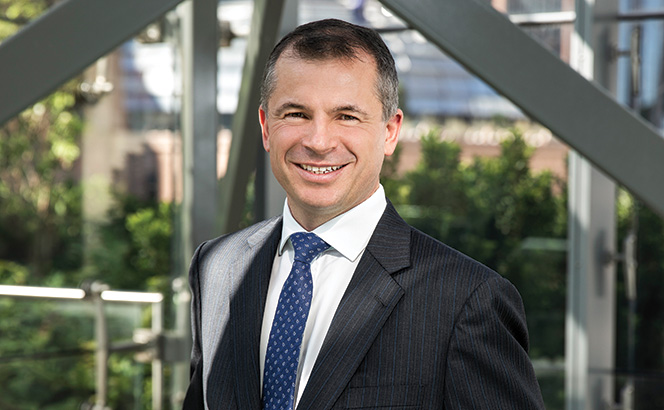Ashurst has marked its seventh consecutive year of revenue growth, with a 10% increase in turnover for 2022/23 from £798m to £879m. While this represents slower growth than than last year’s 12% jump, this is still above its seven-year average of 8% annual growth.
However, PEP was down very slightly: £1.17m, compared to £1.175m last year. This stalling stands in contrast to last year’s 13% increase, though it is offset by an increase in partner headcount, from 447 last year to 469 this year. The firm made 28 lateral hires in the last financial year, and lost six partners, for a net gain of 22.
Ashurst again reported that over 85% of its revenue came from its five key focus industries of banks and private capital, real estate, technology, infrastructure, and energy and resources.
Over half of the firm’s revenue came from the UK, continental Europe, and Middle East, which accounted for approximately 35%, 15%, and 4%, respectively. Global CEO Paul Jenkins (pictured) noted ‘above-benchmark growth in the Middle East, continental Europe, and Germany in particular’. He also pointed to the US as a ‘priority growth market’, citing growth there of 20% – above the 15% the firm reported last year.
Jenkins put growth in the firm’s global disputes, investigatory, and advisory division, which incorporates the dispute resolution, competition, employment, IP and media, and tax teams, at around 20%. The firm also reported a similar rate in work relating to the energy transition in the US, France, Germany, and Australia.
The firm’s static profitability, meanwhile, gave Jenkins no cause for concern: ‘In a year of challenging macroeconomic conditions and a slowdown in transactional markets, we’re very happy to achieve this level of revenue growth and to maintain our profitability. All firms have seen their cost base significantly increase over the last year, including through higher inflation and rising costs. There is also continued investment needed in IT, including generative AI, to keep pace with advancements in technology. We’re happy with the year we’ve had.’
This year’s figures saw the firm hit the targets for 2023 it laid out in its strategy in 2019. Now, the firm looks ahead to the next four years with its 2027 strategy. ‘Our aim is to continue to grow, particularly in our priority markets, specifically the UK, France, Germany, the Middle East, Singapore, the US, and Australia.
‘We aim to maintain our focus on our core industries and double down on our strengths in core practice areas. In the US, we have strength in infrastructure and financial institutions. The missing part is in our other core industries – energy, real estate, private capital, and technology – and that’s where we’re going to invest.’
The firm was also bullish about its expanded offering, including its New Law division Ashurst Advance, which saw revenue growth of over 25%, and its risk advisory business, which expanded into the UK in the last year.
Looking ahead, Jenkins said: ‘The challenges and opportunities are interlinked. For example, the challenges include the continued drive to provide more for less, to use technology to the benefit of our clients, to make sure that it’s augmenting our services – which we are doing through our New Law business, Ashurst Advance, one of the fastest-growing areas of our firm. We also need to make sure we continue to retain and attract the best talent.’














